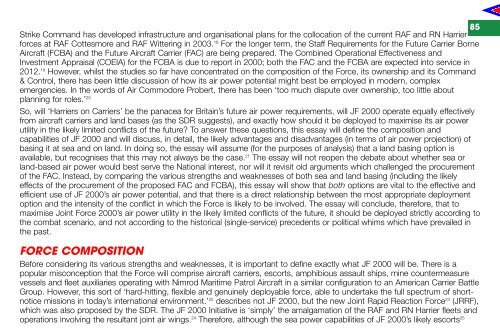THE RAF AIR POWER REVIEW - Royal Air Force Centre for Air ...
THE RAF AIR POWER REVIEW - Royal Air Force Centre for Air ...
THE RAF AIR POWER REVIEW - Royal Air Force Centre for Air ...
Create successful ePaper yourself
Turn your PDF publications into a flip-book with our unique Google optimized e-Paper software.
85<br />
Strike Command has developed infrastructure and organisational plans <strong>for</strong> the collocation of the current <strong>RAF</strong> and RN Harrier<br />
<strong>for</strong>ces at <strong>RAF</strong> Cottesmore and <strong>RAF</strong> Wittering in 2003. 18 For the longer term, the Staff Requirements <strong>for</strong> the Future Carrier Borne<br />
<strong>Air</strong>craft (FCBA) and the Future <strong>Air</strong>craft Carrier (FAC) are being prepared. The Combined Operational Effectiveness and<br />
Investment Appraisal (COEIA) <strong>for</strong> the FCBA is due to report in 2000; both the FAC and the FCBA are expected into service in<br />
2012. 19 However, whilst the studies so far have concentrated on the composition of the <strong>Force</strong>, its ownership and its Command<br />
& Control, there has been little discussion of how its air power potential might best be employed in modern, complex<br />
emergencies. In the words of <strong>Air</strong> Commodore Probert, there has been ‘too much dispute over ownership, too little about<br />
planning <strong>for</strong> roles.’ 20<br />
So, will ‘Harriers on Carriers’ be the panacea <strong>for</strong> Britain’s future air power requirements, will JF 2000 operate equally effectively<br />
from aircraft carriers and land bases (as the SDR suggests), and exactly how should it be deployed to maximise its air power<br />
utility in the likely limited conflicts of the future? To answer these questions, this essay will define the composition and<br />
capabilities of JF 2000 and will discuss, in detail, the likely advantages and disadvantages (in terms of air power projection) of<br />
basing it at sea and on land. In doing so, the essay will assume (<strong>for</strong> the purposes of analysis) that a land basing option is<br />
available, but recognises that this may not always be the case. 21 The essay will not reopen the debate about whether sea or<br />
land-based air power would best serve the National interest, nor will it revisit old arguments which challenged the procurement<br />
of the FAC. Instead, by comparing the various strengths and weaknesses of both sea and land basing (including the likely<br />
effects of the procurement of the proposed FAC and FCBA), this essay will show that both options are vital to the effective and<br />
efficient use of JF 2000’s air power potential, and that there is a direct relationship between the most appropriate deployment<br />
option and the intensity of the conflict in which the <strong>Force</strong> is likely to be involved. The essay will conclude, there<strong>for</strong>e, that to<br />
maximise Joint <strong>Force</strong> 2000’s air power utility in the likely limited conflicts of the future, it should be deployed strictly according to<br />
the combat scenario, and not according to the historical (single-service) precedents or political whims which have prevailed in<br />
the past.<br />
FORCE COMPOSITION<br />
Be<strong>for</strong>e considering its various strengths and weaknesses, it is important to define exactly what JF 2000 will be. There is a<br />
popular misconception that the <strong>Force</strong> will comprise aircraft carriers, escorts, amphibious assault ships, mine countermeasure<br />
vessels and fleet auxiliaries operating with Nimrod Maritime Patrol <strong>Air</strong>craft in a similar configuration to an American Carrier Battle<br />
Group. However, this sort of ‘hard-hitting, flexible and genuinely deployable <strong>for</strong>ce, able to undertake the full spectrum of shortnotice<br />
missions in today’s international environment.’ 22 describes not JF 2000, but the new Joint Rapid Reaction <strong>Force</strong> 23 (JRRF),<br />
which was also proposed by the SDR. The JF 2000 Initiative is ‘simply’ the amalgamation of the <strong>RAF</strong> and RN Harrier fleets and<br />
operations involving the resultant joint air wings. 24 There<strong>for</strong>e, although the sea power capabilities of JF 2000’s likely escorts 25

















